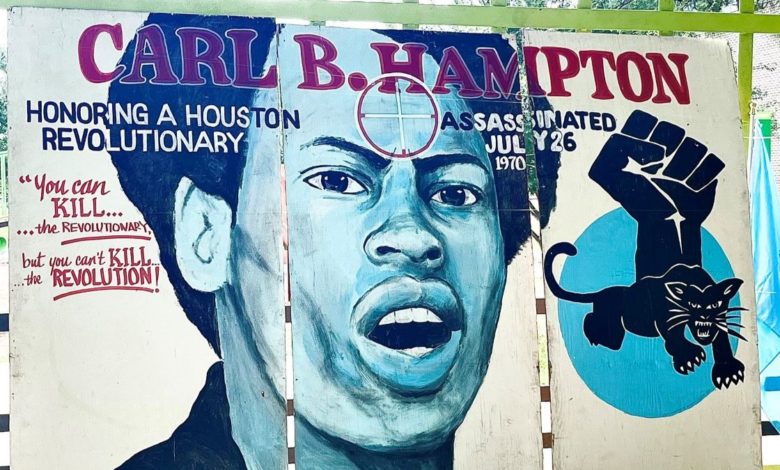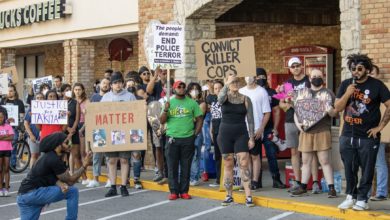
On July 26, 1970, the Houston Police Department assassinated one of the leaders of Houston’s Black liberation movement, 21-year-old Carl Bernard Hampton — unrelated to Black Panther Party member Fred Hampton. Hampton was the founder and chairman of the People’s Party II, a revolutionary organization founded in 1969 and modeled after the Black Panther Party for Self-Defense.
Around 100 people gathered in Houston’s Pleasantville community on the afternoon of July 23, three days before the anniversary, to commemorate the young revolutionary’s life, honor him and renew focus on the ongoing struggle against the oppressive system of capitalism and racism that Hampton dedicated his life to fighting.
A revolutionary People’s Party is formed
Carl Hampton was born on Dec. 17, 1948, and grew up in the the predominantly Black Pleasantville community in Houston. In 1969 he traveled to Oakland, California, and spent time with the Black Panther Party for Self-Defense. His time there convinced him of the need to form a chapter of the party in Houston. The party, facing severe state repression from local, state, and federal agencies as part of COINTELPRO, was not authorizing new chapters at the time. Hampton formed his own party, modeled after the Panthers, calling it the People’s Party II.
The People’s Party II set up its headquarters on Dowling Street — now Emancipation Avenue — in Houston’s Third Ward. Hampton and the party worked to organize the people to defend their communities against racist police harassment and terror, particularly after a Black man in neighboring Galena Park named Bobby Jo Conner was beaten to death by police.
They provided basic needs to the community, such as food and clothing. Following in the footsteps of Fred Hampton’s Rainbow Coalition, they allied with working-class white and Mexican revolutionary organizations, such as the John Brown Revolutionary League and the Mexican American Youth Organization. The forging of this working class coalition, the party’s political education classes, and the organizing of impoverished Black communities against police violence earned the ire of local authorities, who would soon bring the full force of the state down on the party.
A police execution on Dowling Street
On July 17, 1970, Carl Hampton confronted two police officers who were harassing a young Black man near party headquarters on Dowling Street for selling copies of the Black Panther newspaper. One of the officers, outraged that Hampton had a firearm in his holster, which legally he was permitted to do, decided to reach for his own firearm. Hampton responded by drawing his weapon in his self-defense. Police called for back-up, and soon armed members of the local community showed up to defend Hampton. Police dressed in riot gear flooded into the Third Ward and a ten-day standoff ensued.
Police demanded Hampton turn himself over for arrest, but the young revolutionary saw no reason to put his life in their hands. “A whole lot of people have placed their lives on the line for purposes and ideals I believe in,” said Hampton. “I can’t turn myself in. I’m not going down there [to the police station]. If they want to deal with my lawyers, okay. If not, well, I’ll just be a fugitive from justice.”
Police, overwhelmed by the militancy of the community in their defense of Hampton, temporarily withdrew from the area and changed course. A special unit of the of the Houston Police Department was tasked with carrying out the execution of Carl Hampton. On July 26, the tenth day of the standoff, police with the special Criminal Intelligence Division were allowed access to the rooftop of the local St. John’s Baptist Church, where they had an unobstructed view of the People’s Party II headquarters.
That night, after being warned that there were several armed white men on top the church, Hampton went out to the street to investigate. Using night vision scopes and illegal hollow-point dum-dum bullets, Houston police shot Carl Hampton multiple times, hitting him in the stomach and chest and causing him to fall to the ground. A woman named Sophia Powell was able to drag his body to her car and drove him to Ben Taub General Hospital. He was pronounced dead in the early morning hours of July 27. He was just 21 years old.
A grand jury subsequently declined to indict the officers who murdered him. To this day no one has been held accountable for this crime.
Carl Hampton’s legacy lives on
Fifty-two years after Carl Hampton’s assassination, the legacy of the young Black revolutionary is still bringing different sections of the working class together. At the commemorative event, which was sponsored by the National Black Panther Alumni Association, there were speeches and poems from a wide array of organizations including the National Black United Front, S.H.A.P.E. Community Center, Nation of Islam, the Brown Berets and the Palestinian Youth Movement.
Mohammed Nabulsi from the Palestinian Youth Movement spoke about the history of collaboration and joint struggle between the Black liberation movement in the United States and the Palestinian freedom movement, as well as the continued need for global solidarity. He said, “From when Huey Newton visited Gaza refugee camps to when George Jackson was exchanging letters with Palestinian prisoners while in prison in California, we recognize that our struggles and the struggles of all oppressed peoples are intertwined. Our enemy is your enemy and your enemy is our enemy … Long live Carl Hampton’s legacy. Long live internationalism. Long live joint struggle and salutations to our martyrs and our prisoners, until liberation!”
The fight for Black liberation and a revolution that upends the capitalist system will continue. Carl Hampton’s life and legacy prove once again that, as Fred Hampton said, while you can kill a revolutionary, you can never kill the revolution.
Feature photo: Carl Hampton was assassinated by Houston police in 1970. Liberation photo






